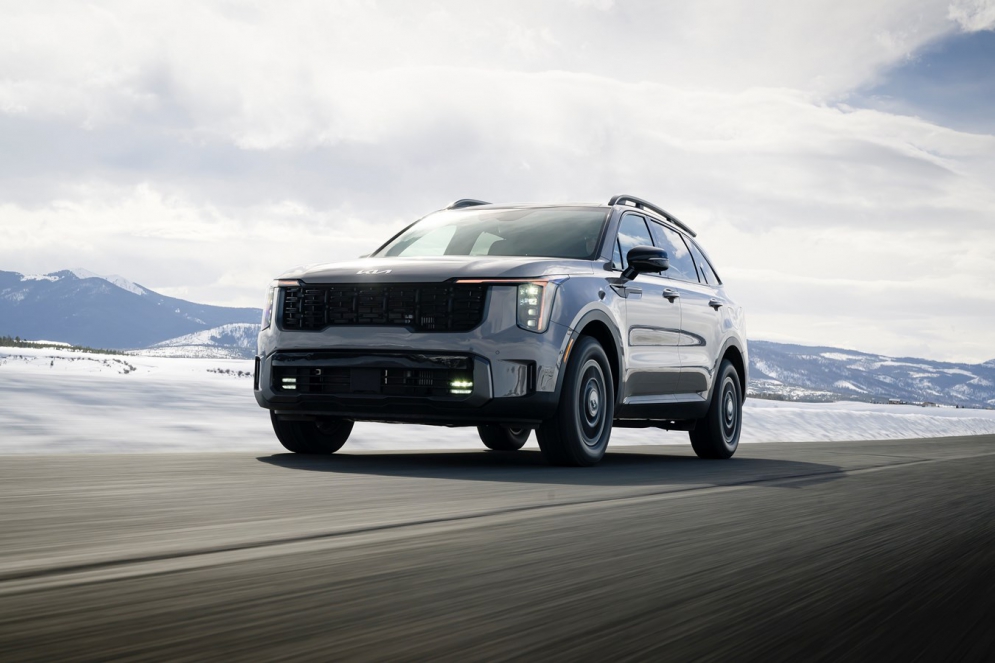LOOKS
The last full redesign for the Sorento came back in 2021, but some updates were made to the exterior design in 2024, including a rugged new look for the front grille as well as new lighting designs.
The X-Pro version of the Sorento was also introduced in 2024, including a center locking differential and 17-inch all-terrain tires to improve traction and assist with basic off-roading.
The overall design is sleek and attractive, and at first glance you wouldn't assume it would have three rows. Other design features include a panoramic sunroof with power sunshade, smart power liftgate, LED projector headlights, taillights and fog lights, roof rails, and power-folding heated mirrors with LED turn signals.
Moving inside the Sorento, you’ll find a strong design and seating for either six or seven people, depending on whether you choose Captain’s Chairs or a bench in the second row.
The high-quality leather seating offers excellent comfort for both short and long rides, and those who choose the Captain’s Chairs will not be disappointed at the comfort level.
Both first and second rows offer plenty of legroom and headroom. Be aware though, that the third row is a bit tight and best for children or shorter adults.
There are plenty of small storage spaces in the Sorento, and it allows for easy access to the third row. The heated seats also work very quickly and effectively.
Cargo space numbers are competitive with other midsize SUVs — coming in at 76 cubic feet with both rear rows down, 45 cubic feet with 3rd row down, and 13 cubic feet with all seats up.
HOW’S THE RIDE?
The Sorento I tested featured a turbocharged, 2.5-liter, four-cylinder engine, which delivered 281 horsepower and 311 pound-feet of torque, as well as an 8-speed automatic transmission.
There is also a base, non-turbo engine offered that offers a more sedate 191 horsepower and 181 pound-feet.
Regardless of your engine choice, the Sorento is offered in both FWD and AWD versions.
There is also a hybrid Sorento offered, powered by a 1.6-liter turbocharged four-cylinder engine that is paired with an electric motor to deliver 227 horsepower and 258 pound-feet. And a plug-in hybrid is also available.
Drive modes on the Sorento, controlled by a dial in the center console, include Smart, Sport, Eco, Normal and Snow; Snow mode will come in handy for folks in areas with inclement weather.
I found the Sorento with the turbo engine to be quite fast and fun to drive. The 0-to-60 times are impressive, coming in at just over 6 seconds, and the engine’s power makes it easy to pass other cars or merge onto the highway.
Overall, it’s an excellent driving experience that's competitive in class, proving to be agile when needed, fun on curvy roads, and both accelerating and braking effectively. The engine is not overly loud and the cabin blocks outside noises effectively.
If you’re looking to tow with the Sorento, the X-Pro model will allow you to pull up to 4,500 pounds.
TECHNOLOGY, SAFETY
The Kia Sorento’s tech setup is centered around a well-designed 12.3-inch touchscreen that responds immediately to driver input and should be easy to figure out even for less tech-savvy folks. There’s also a large digital display in front of the driver displaying all essential information.
Where Kia goes wrong with their tech setup is a second set of controls below, which are used to control both radio and climate functions. The issue is they make you toggle back and forth between radio and climate controls, which can be tricky while you are driving. It’s not the end of the world, but I would have preferred dedicated controls for each.
Other tech features include Kia Connect (which allows unlocking/locking, and other functions from your phone), a Navigation system, satellite radio, wireless phone charger, multiple USB charge ports, plus wireless Apple CarPlay and Android Auto.
Other tech options include an impressive 12-speaker Bose stereo system, and a rear-seat entertainment setup.
Moving on to safety, the Sorento is well-equipped with a full array of driver aids that match rivals in its class.
One highlight is the Highway Driving Assist system, a limited self-driving system that uses lane centering and adaptive cruise control and will keep the vehicle moving straight between the lines. Your hands must remain on the wheel, but it works very effectively and is extra helpful on longer highway drives.
There’s also a Surround View monitor that is helpful in parking situations due to its offering a birds-eye view around the vehicle.
Airbags are included throughout the vehicle, and other safety features include:
— Standard automated emergency braking with pedestrian and cyclist detection
— Blind Spot View Monitor
— Forward Collision-Avoidance Assist
— Blind-Spot Collision Avoidance Assist-Rear
— Rear Cross-Traffic Collision Avoidance Assist
— Lane Keeping Assist and Lane Following Assist
— Driver Attention Warning
— Safe Exit Assist
— Parking Distance Warning – Forward/Reverse
MPG
Fuel mileage will vary based on the engine chosen.
The Kia Sorento with the base engine and FWD delivers 23 city/31 highway/26 combined. Base engine with AWD gets you 23 city/28 highway/25 combined
The turbocharged engine with FWD gets you 20 city/29 highway/23 combined. And the Turbo engine with AWD, which is what I tested, gets you 20 city/27 highway/23 combined.
The hybrid Sorento offers up to 36 mpg. And a plug-in hybrid gets you 79 MPGe, and 35 mpg city/33 mpg highway with gas engine only.
In my real-world testing, I was a bit under the listed numbers for the turbo engine, averaging just over 19 miles per gallon. Though as you can see from the various options offered, buyers who must have stronger fuel economy have plenty of options for other Sorento packages that will deliver considerably better numbers, especially the hybrid models.
In the grand scheme of SUVs and fuel mileage, the Sorento isn’t going to lead its class, but will also be better than some rivals.
PRICE
The Sorento X-Pro SX-Prestige that I tested was at the top of the price range, coming in at just over $49K. But the price range on the Sorento is pretty affordable in the grand scheme of things, starting at $33K.
A wide variety of trims are available, including: LX, S, EX, SX and SX Prestige. There are also X-Line and X-Pro versions offered on several trim levels.
If you don’t want to be at the high end of the range, but are willing to move up from the base model, you can get a well-equipped Sorento for under $40K. Even lower trims offer an impressive amount of features and quality materials.
In addition, the Sorento comes in both hybrid and plug-in hybrid options, starting around $39K and $48K respectively.
Also worth mentioning are the excellent warranties on the Sorento, including:
— 10-year/100,000 mile powertrain warranty
— 5-year/60,000 mile bumper-to-bumper warranty
— 5-year/60,000 mile roadside assistance
BOTTOM LINE
The Kia Sorento is a sharp-looking, powerful and fun-to-drive three-row SUV that is smaller and less expensive than a Telluride.
If you’re a fan of the Kia lineup who wants to save a few dollars while still getting a strong family vehicle with plenty of seats and cargo room, the Sorento will fit the bill perfectly.
===
AutoTechReviews.com can be found on Twitter @AutoTechReview, or stay updated at the AutoTechReviews Facebook page. Follow AutoTechReviews on Instagram at @Autotechreviews or on TikTok at @AutoTechReviews.. Matt Myftiu can be found on Twitter @MattMyftiu.




